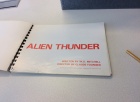Rising engineer Wendy Lee works for energy company Paloma North and is unsure of the future she worked so hard for. As rumours of layoffs circulate in her small, isolated team, Wendy’s monotonous routine crumbles. Long days in the field and long nights alone begin to take their toll in the form of ambivalence. With support, and often-questionable guidance from her coworkers, Wendy must navigate personal ethics and corporate interest within one of Canada’s most controversial industries.
Awarded one of three 2017 Calgary Film Centre Production grants, Gillian McKercher is making her first feature-film, Circle of Steel, a satirical semi-autobiography based on McKercher’s experiences as a chemical engineer over the past four years. With a local soundtrack and the visuals of the Western landscape, Gillian McKercher's Circle of Steel brings a distinct voice to Canadian cinema. This interview is the third of Luma Quarterly’s three-part series following the production of the film, and documenting Gillian’s experience as a first-time feature filmmaker.
This interview has been edited for length.
Ted Stenson (TS): What stage are you currently at in post-production?
Gillian McKercher (GM): We just picture locked! We have passed off the film to our post-sound team and are in prep for colour and VFX. We will also record our score in April. The current picture lock has a few placeholders for a short section of experimental 16 mm images, and I plan to complete those sections within the month. About a year ago, I had the pleasure of seeing a number of Philip Hoffman films at the $100 Film Festival. His work heavily inspires me and informs the images that I hope to create in the next month. I’m also very inspired by the work of local analogue guru Kyle Whitehead. I don’t want to give too much away, but I’m extremely satisfied to combine my love of experimental film within a conventional narrative.
Our goal is to be completely finished by the first week of May. I have ambitions of a fall festival run, and most submission deadlines are May and June. Our next steps are to plan our marketing: to simplify our brand message, how best to reach our target audience, and to consider which platforms align with my vision of the film.
TS: How many people have been involved in the post-production of Circle of Steel and in what capacities?
GM: I am co-editing Circle of Steel with Erin St. Clair. I’ve loved working with her and I would do it again. In addition to our picture editors, I am working with a post-sound team, a composer, a colourist, a VFX artist, and my producers, Executive Producers, and close advisors to complete the film. It’s a big team and I’m thankful for everyone’s patience! In the final stages of locking picture, I am especially grateful to my friends and peers who offer feedback. I want to be pushed to my artistic limit, and my friends expect only the best of me. I’m really lucky to work with Nicola Waugh on the branding and marketing execution, and I’m also happy to work with Morgan Curley in the graphic design elements of this stage.
TS: Everything you’ve done before Circle of Steel was much shorter: web series, short films, music videos… What had been your previous experience of the post-production process?
GM: When I made the second season of The Calgary Collection, I edited, coloured, and organized the release party while I worked 12 hour, 14-day shifts at Surmont. I had to work about six to seven hours each evening after work to complete the project. That set the tone for the grind of small-budget and independent filmmaking. I was also the sole producer and was in charge of all financing and budgeting, which gave me a lot of perspective about finishing costs.
The stakes are much higher for a feature film—you only have one chance to make a debut—and the pressure that I feel to succeed is intense.
Prior to Circle of Steel, music was often an afterthought to the production. My previous projects suffered without the active consideration of score in pre-production, and I made music a top priority with my feature. I’ve been speaking with Simone Schmidt (Fiver) and Rebecca Bruton for over a year in prep for the film, and their early input has set the sonic tone for the film. Simone actually delivered to us a final mix of “Show Me The Mark,” Circle of Steel’s original song, before we finished production. I thought it was critical to receive a song in its final form while we finished production. “Show Me The Mark” really guided me on the film’s attitude and point of view, and its inclusion is much more balanced. My directorial choices were informed by “Show Me The Mark,” and her songwriting was informed by my original vision of the film. In a way, “Show Me The Mark” kept me accountable to my primary conception of Circle of Steel.
TS: Has collaboration been challenging given that on your previous films you were more or less solely responsible for editing, sound design, etc.?
GM: I love collaborating with others. With a project of this scale and on this tight budget, I cannot do everything alone. It would be impossible. The hardest part of leading a team is learning how to articulate your vision clearly. A few times, I feel like I’ve asked Erin to re-do work because I was unsure how to express what I needed. With Rebecca, our composer, I’ve spent hours writing her a simple e-mail because I’m unused to dictating my mind about score. It’s been a massive learning curve.
TS: Do you feel your previous experience has been applicable to working on a feature film or is it completely different?
GS: Yes . . . On one hand, making a feature has been a luxury compared to shorter projects because there is much more room for creativity. For example, the duration bandwidth for an acceptable feature length is 80-120 minutes, which offers a lot of flexibility compared to only a couple of minutes for a short film. At the same time, a feature is incomparably more emotionally, physically, and financially demanding. The stakes are much higher for a feature film—you only have one chance to make a debut—and the pressure that I feel to succeed is intense. The distribution and funding game of the feature level is incomparable to that of a short. Distribution is strategic and oftentimes political, and I’ve only just glimpsed the depths of what a successful partnership can mean. We haven’t received any funding from Telefilm, and Circle of Steel is at a distinct disadvantage for representation by the organization. Keep in mind that almost all Canadian content is funded by Telefilm (Room (2015), Brooklyn (2015), It’s Only The End of the World (2016)). To be an outsider to the conventional funding model is to take the massive risk to be omitted from national and international meetings that only Telefilm, as a Canadian crown corporation, can access.
TS: What are the challenges in trying to shape a narrative at a feature length vs. something shorter, like a short film or music video? Do you feel like you have more control or less?
GM: I love crafting a narrative film. So far, Circle of Steel has been the best creative experience of my life. In a feature length film, there’s a lot of room to explore the boundaries of a character. In one cut, Circle of Steel felt like an ensemble film, in another, Kiki is more aggressive, in another, Wendy is noticeably pricklier. The editing process has been this incredible time where we try to close the loop from my original vision. Production changes everything, but post-production ensures that the point of view, my voice, is sustained. The first round of feedback I received was liberating: I was freed from the structure of my script so that I could better represent the core message of Circle of Steel. I don’t care if my intermission becomes a prologue or if one conversation gets cut. What I do care about is if the film is engaging, if the emotional beats are hit, if my point of view is clear. My foremost goal as a director is to serve the film to be its best form. I cannot, will not, allow a personal fear or insecurity to debilitate the film from becoming its best version.
TS: How has mentorship influenced the process? Do you view it differently now that you are nearly finished making the film?
GM: Mentorship has been an important aspect of the first-time feature filmmaking process. I am very lucky to have Gary Burns and Avi Federgreen on my team as Executive Producers and Mentors. Both have made numerous films, and their experience both practically and critically has benefitted Circle of Steel. During pre-production and production, we called Avi frequently with questions for which we were unprepared. Gary has been providing me critical feedback since the early drafts of the script. In the post process he assuages my artistic insecurities with feedback on cuts and when he listens to me run-on about my fright of failure.
I believe that people are compelled to create. Even in the most oppressive and unlikely of situations, we have an urge to express our experiences, to make our lives “less grey.”
I think there are two important aspects of mentorship. The first is to provide assurance that everything will be okay, to bridge the gap between the inaugural and seasoned filmmaking experience. The second is to clearly define levels of excellence and encourage the mentee towards their achievement. I don’t think that a mentor needs to be sweet or even kind (although both Avi and Gary are lovely, kind, and sweet people). A good mentor should push the mentee towards the creation of the best craft, the confidence of artistic autonomy and agency. And as a mentee, my responsibility is to honour the time that my mentors give me with trust, respect, and the hardest work I can possibly do. I don’t want to speak for Gary and Avi, but I had a great experience with their involvement!
TS: Based on what you’ve experienced so far, is the micro-budget level of funding adequate to produce a feature film of this scope? If you had more funding, what would you spend it on?
GM: I have a lot of mixed feelings about micro-budget level productions, and a lot of my pre-existing judgments are now validated now that I am almost done Circle of Steel. Firstly, anything is possible with passionate and talented people. I believe that people are compelled to create. Even in the most oppressive and unlikely of situations, we have an urge to express our experiences, to make our lives “less grey.” I believe in an artist’s agency to choose their projects; but I also believe that the trend of micro-budget funding takes advantage of eager, emerging, and oftentimes financially poor filmmakers.
To make a feature film below $150K asks all workers to receive a fee along the lines of an honorarium. Many of the crew on Circle of Steel were paid below their regular rates. My mom, who was our caterer and accountant, donated her fees in-kind of just over $4000. Interim funding on a micro-budget scale is often taken at personal cost, whether it’s by a line of credit or by a loan from a family friend. Even with a team of experienced distributors and Executive Producers, the weight of a production ultimately comes down to the owners of the production company, who are probably the producer and director of the film and who likely made their film on an entire year’s vacation time and on an average salary. They will likely be unable to justify paying themselves for their numerous hours of work. Realistically, a micro-budget’s chance of success is low: for every Black Cop (2017) or Werewolf (2016), there is another film that will fail to meet its goals of distribution. Passion makes the micro-budget trend possible and in the best of scenarios, the launching pad of a career, but it is also an unsustainable model for high caliber emerging content. I don’t think that it’s by chance that directorial debuts with budgets of $1 million are able to reach larger audiences: think of Lady Bird (2017), Get Out (2017), Reservoir Dogs (1992), or Hard Eight (1996). Don’t even bring up Kevin Lowry’s A Ghost Story (2017) as a comparable, successful micro-budget film: his entire team is far from emerging and he has the financial security of a big-budget Disney paycheck (see Pete’s Dragon (2016)).
If I had more funding, I would pay my crew better and I would pay for an extra three days of shooting. I don’t believe in the perpetuation of unpaid or less-than-living-wage labour. I would also pay for film stock. I wanted to make Circle of Steel on 16 mm. Luckily, I’m about to make a music video with my longtime collaborator Amy Nelson on 16 mm, but the goal is a feature. For comparison, Never Steady, Never Still (2017), the first-time feature debut of Canadian Kathleen Hepburn, was shot on 16 mm and for just under $1 million. Hopefully, I can get to that level for my next feature film!
TS: Has this post-production process changed how you will direct in the future?
GM: Everything about Circle of Steel has changed how I will direct in the future! I know now that my schedule was too ambitious; although I’m on-track for all my festival submissions, a final product 2½ months after production wrap, and over a Christmas break, was ambitious for the size of our team. In co-editing Circle of Steel, I’ve learned a lot about my strengths and fallbacks as a director. I like to think that the editing experience is a feedback loop into my pre-production visualization and production sensibilities, and that I will become stronger and more intuitive in the next project. I noticed that I was most confident in the last week of our production, and it yielded the best footage. I’m ambitious: I want Circle of Steel to surprise and impress people and I want national confidence to invest in my next films! I want to direct at least three more movies and produce the works of my peers!
McKercher plans to start Circle of Steel’s festival run in September 2018, with a theatrical release in 2019.
Find Gillian McKercher’s collected interviews here:
Part 1—Pre-Production: “Creating a Baseline”
Part 2—Production: “Choice With Context, Endurance… & Dr. Dre”






